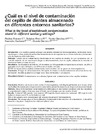Identificador persistente para citar o vincular este elemento:
https://accedacris.ulpgc.es/handle/10553/70602
| Título: | ¿Cuál es el nivel de contaminación del cepillo de dientes almacenado en diferentes entornos sanitarios? | Otros títulos: | What is the level of toothbrush contamination stored in different sanitary settings? | Autores/as: | Medina-Patruno, C. Bolaños-Rivero, Margarita Martín-Sánchez, Antonio Manuel Saavedra Santana, Pedro Vicente-Barrero, M. |
Clasificación UNESCO: | 32 Ciencias médicas 3210 Medicina preventiva |
Palabras clave: | Contaminación microbiana Higiene oral Contaminación de los cepillos dentales |
Fecha de publicación: | 2019 | Publicación seriada: | Avances en odontoestomatologia | Resumen: | Introduction
Brushes can house a wide variety of microorganisms, including fungal bacteria and viruses, which can facilitate the translocation of species in the same individual and the transmission of species between individuals.
Methods
Study of the bacterial contamination of toothbrushes of one hundred volunteers with the completion of a questionnaire (place of storage, type of brush, use of storage case and months of use).
Results
A total of 100 samples were studied. 33% kept the brush outside the bathroom, 20% kept it in the bathroom drawer and 47% on the bathroom sink.
92% of the samples were contaminated with at least one group of microorganisms.
Conclusion
The storage place of the toothbrush is fundamental in the reduction of contamination. It should be stored in a dry place, away from the toilet and without a box. Introducción Los cepillos pueden albergar una amplia variedad de microorganismos, incluyendo bacterias hongos y virus, pudiendo así facilitar la translocación de especies en un mismo individuo y la transmisión de especies entre individuos. Metodos Estudio de la contaminación bacteriana de los cepillos de dientes de cien voluntarios con la cumplimentación de un cuestionario (lugar de almacenamiento, tipo de cepillo, utilización de estuche de almacenamiento y meses de uso). Resultados Se estudiaron un total de 100 muestras. El 33% guardaba el cepillo fuera del baño, un 20% lo guardaba en el cajón del baño y un 47% sobre el lavabo del baño. El 92% de las muestras estaban contaminadas como mínimo con un grupo de microorganismos Conclusión El lugar de almacenamiento del cepillo de dientes es fundamental en la reducción de la contaminación. Se debe guardar en un lugar seco, lejos del inodoro y sin estuche. |
URI: | https://accedacris.ulpgc.es/handle/10553/70602 | ISSN: | 2340-3152 | Fuente: | Avances en odontoestomatología [ISSN 2340-3152], v. 35 (2) p. 69-72 |
| Colección: | Artículos |
Visitas
140
actualizado el 16-dic-2023
Descargas
72
actualizado el 16-dic-2023
Google ScholarTM
Verifica
Comparte
Exporta metadatos
Los elementos en ULPGC accedaCRIS están protegidos por derechos de autor con todos los derechos reservados, a menos que se indique lo contrario.
